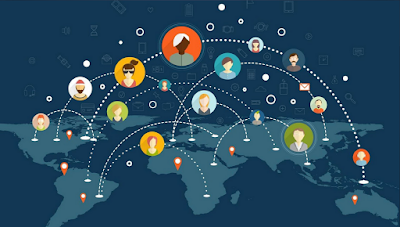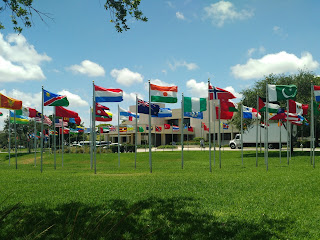Globalization: The World is Flat Vs. Cultural Intelligence
The World is
Flat.
Friedman’s theory on states that
Globalization 1.0 lasted from 1492 to the early 1800s, it marked the beginning
of global exploration and shrunk the world from a size “large” to a size
“medium”. It is characterized by countries exploring the world and colonizing other
nations; Globalization 2.0 lasted from the 1820s to 2000, it shrunk the world
from size “medium” to size “small” and characterized by Companies going global
through trade and operations in foreign nations; Globalization 3.0 era just
started after 2000, it shrinks the world from size “small” to size “tiny” and
“flattening” the economic playing field at the same time. This is characterized
by Individuals globalizing through connecting, collaborating and competing with
themselves.
In Thomas Friedman’s perspective, there
has been an evolution of globalization due to certain events that occurred
inadvertently through the fall of communism, the rise and proliferation
technology and the optimization of business processes. This concept is true
because through the technology like the internet and manufacturing process
standardization, collaboration with multi-located or virtual teams have
produced creative and efficient products and services. However, I disagree with certain aspects of
this theory. First, I do not agree that there are 10 Flatteners as stated by
Thomas Friedman because Flatteners Outsourcing, Offshoring and Insourcing are
the same concepts. According to Merriam Webster dictionary; Outsourcing is to
procure from outside sources, which is the same as offshoring – producing in a
foreign country (outside source). Insourcing – is same as outsourcing with only
a change in the flow of the transaction.
The UPS example of Insourcing means that UPS has taken up the
responsibility from Toshiba or the IT firm, which is same as the IT firm or
Organization outsourcing to UPS. Hence all three flatteners Outsourcing,
Offshoring, and Insourcing are the same concepts, therefore, there should be 8
flatteners only.
Second, Friedman did not consider the role
of international trade agreements which provided an environment for the
exchange of goods and services. Technology and processes only enhanced the
implementation of these agreements. For example, if there were no trade
agreements with China, outsourcing to China would not be possible. Third, the
world is not flat in terms of the differences between cultures and as such
Intercultural intelligence is required for an effective globalization policy
within an organization. The world is not also “flat” or as “tiny “as Friedman’s
assumed due to the challenge of the Digital divide since only 40% of the
world’s population is on the internet. There are still possibilities of the
world getting “flatter” or “tinier” however Friedman successfully put forward a
pattern to globalization.
Cultural
Intelligence
Despite the trend to globalize, Peter
Alfandary believes that globalization is an oxymoron because individuals
involved operate in their own different cultural sphere. He gave an example of
the meeting he had with some Japanese client who kept saying “yes”, only to
realize that “yes” meant “We have heard you” to the Japanese. Culture shock is
now invisible as it is hidden behind the technology, as we rely more on emails
(instead of conversations) and assume that since English is spoken widely as
the business lingua franca, we are understood, without cognizance the others
context, perception, cultural variables or interpretation.
An example is a case of a German trainer
kept complaining that African colleagues late to the sessions, however in the
African culture, time is not a precise measure, so for a 9:00 am meeting could
be 9:20 am, the trainer learned the culture and adjusted her strategy by
starting when up to ten people were present. Another example is ordinarily
Nigerian lunch time is only an hour and can be moved for meetings but in Huawei
Nigeria, the break lasts for 2 hours and in that time staff can lay on the
floor sleeping, watch movies and the office lights were turned off and no meeting
can be held at that time, this is because this is a Chinese firm and had
inherited its cultural break time practices. These examples show that if the training was online or an online meeting was scheduled with Huawei staff during
lunchtime, the ones on the other end of the spectrum may not realize the
culture difference involved in these simple communications.
Globalization is a myth or more complex
than we realize with respect to cultures as the globalization involves
heterogeneous cultures and villages which brings certain complications and as
such a homogenous solution does not necessarily exist especially when
interacting with a multicultural team. The realization of this differences in
cultures expresses cultural intelligence is required in the to ensure effective
interactions occur in a globalized environment.
On the other hand, although I do not agree with Friedman’s exaggeration
in the “shrinking” world size, I think Globalization 4.0 should be about
inclusion and speed. About 60 percent of the world population are unable to
benefit from globalization due to issues of the digital divide, conflict,
illiteracy and poor internet infrastructure. By including more people, we stand
to gain an exponential increase in creativity, innovation, and trade, with
these Increase internet speed and efficient speedy delivery of goods and
services are required. This era would be characterized by the further shrinking
of time and space, increased inclusion, and intercultural intelligence.
Reference
Friedman, T. L.
(2009). The world is flat: a brief history of the twenty-first century.
Bridgewater, NJ: Distributed by
Paw Prints/Baker & Taylor.
T. (2015, June
05). The myth of globalization | Peter Alfandary | TEDxAix. from https://www.youtube.com/watch?v=xUYNB4a8d2U


Comments
Post a Comment